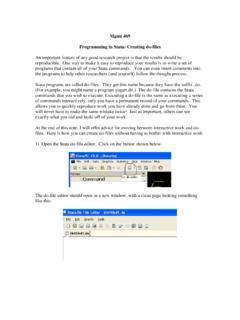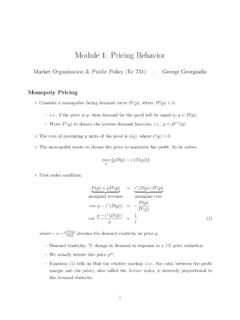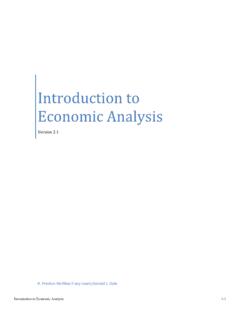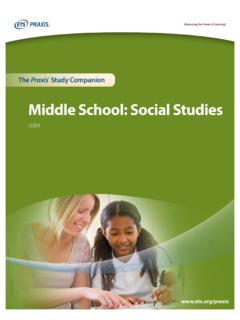Transcription of The Columbian Exchange: A History of Disease, Food, and Ideas
1 Journal of Economic Perspectives Volume 24, Number 2 Spring 2010 Pages 163 188 TThe Columbian Exchange refers to the exchange of diseases, Ideas , food he Columbian Exchange refers to the exchange of diseases, Ideas , food crops, and populations between the New World and the Old World crops, and populations between the New World and the Old World following the voyage to the Americas by Christo pher Columbus in the voyage to the Americas by Christo pher Columbus in Old World by which we mean not just Europe, but the entire Eastern The Old World by which we mean not just Europe, but the entire Eastern Hemisphere gained from the Columbian Exchange in a number of ways.
2 Discov-Hemisphere gained from the Columbian Exchange in a number of ways. Discov-eries of new supplies of metals are perhaps the best known. But the Old World also eries of new supplies of metals are perhaps the best known. But the Old World also gained new staple crops, such as potatoes, sweet potatoes, maize, and cassava. Less gained new staple crops, such as potatoes, sweet potatoes, maize, and cassava. Less calorie-intensive foods, such as tomatoes, chili peppers, cacao, peanuts, and pineap-calorie-intensive foods, such as tomatoes, chili peppers, cacao, peanuts, and pineap-ples were also introduced, and are now culinary centerpieces in many Old World ples were also introduced, and are now culinary centerpieces in many Old World countries, namely Italy, Greece, and other Mediterranean countries (tomatoes), countries, namely Italy, Greece, and other Mediterranean countries (tomatoes), India and Korea (chili peppers), Hungary (paprika, made from chili peppers), and India and Korea (chili peppers), Hungary (paprika, made from chili peppers)
3 , and Malaysia and Thailand (chili peppers, peanuts, and pineapples). Tobacco, another Malaysia and Thailand (chili peppers, peanuts, and pineapples). Tobacco, another New World crop, was so universally adopted that it came to be used as a substitute New World crop, was so universally adopted that it came to be used as a substitute for currency in many parts of the world. The exchange also drastically increased for currency in many parts of the world. The exchange also drastically increased the availability of many Old World crops, such as sugar and coffee, which were the availability of many Old World crops, such as sugar and coffee, which were particularly well-suited for the soils of the New well-suited for the soils of the New exchange not only brought gains, but also losses.
4 European contact The exchange not only brought gains, but also losses. European contact enabled the transmission of diseases to previously isolated communities, which enabled the transmission of diseases to previously isolated communities, which The Columbian Exchange: A History of Disease, Food, and Ideas Nathan Nunn is an Assistant Professor of Economics, Harvard University, Cambridge, Nathan Nunn is an Assistant Professor of Economics, Harvard University, Cambridge, Massachusetts. During the 2009 2010 academic year, he was the Trione Visiting Professor of Massachusetts. During the 2009 2010 academic year, he was the Trione Visiting Professor of Economics at Stanford University, Stanford, California.
5 Nancy Qian is an Assistant Professor Economics at Stanford University, Stanford, California. Nancy Qian is an Assistant Professor of Economics, Yale University, New Haven, Connecticut. Both authors are also Faculty of Economics, Yale University, New Haven, Connecticut. Both authors are also Faculty Research Fellows, National Bureau of Economic Research (NBER), Cambridge, Massachu-Research Fellows, National Bureau of Economic Research (NBER), Cambridge, Massachu-setts, and Affi liates, Bureau for Research and Economic Analysis of Development (BREAD). setts, and Affi liates, Bureau for Research and Economic Analysis of Development (BREAD). Their e-mail addresses are Their e-mail addresses are and and.
6 Doi= Nunn and Nancy Qian164 Journal of Economic Perspectivescausedcaused devastation far exceeding that of even the Black Death in fourteenth-century devastation far exceeding that of even the Black Death in fourteenth-century Europe. Europeans brought deadly viruses and bacteria, such as smallpox, measles, Europe. Europeans brought deadly viruses and bacteria, such as smallpox, measles, typhus, and cholera, for which Native Americans had no immunity (Denevan, 1976). typhus, and cholera, for which Native Americans had no immunity (Denevan, 1976). On their return home, European sailors brought syphilis to Europe. Although less On their return home, European sailors brought syphilis to Europe.
7 Although less deadly, the disease was known to have caused great social disruption throughout deadly, the disease was known to have caused great social disruption throughout the Old World (Sherman, 2007).the Old World (Sherman, 2007).The effects of the Columbian Exchange were not isolated to the parts of the The effects of the Columbian Exchange were not isolated to the parts of the world most directly participating in the exchange: Europe and the Americas. It also world most directly participating in the exchange: Europe and the Americas. It also had large, although less direct, impacts on africa and Asia. European exploration had large, although less direct, impacts on africa and Asia.
8 European exploration and colonization of the vast tropical regions of these continents was aided by the and colonization of the vast tropical regions of these continents was aided by the New World discovery of quinine, the fi rst effective treatment for malaria. Moreover, New World discovery of quinine, the fi rst effective treatment for malaria. Moreover, the cultivation of fi nancially lucrative crops in the Americas, along with the devas-the cultivation of fi nancially lucrative crops in the Americas, along with the devas-tation of native populations from disease, resulted in a demand for labor that was tation of native populations from disease, resulted in a demand for labor that was met with the abduction and forced movement of over 12 million Africans during met with the abduction and forced movement of over 12 million Africans during the sixteenth to nineteenth centuries (Lovejoy, 2000; Manning, 1990).
9 The sixteenth to nineteenth centuries (Lovejoy, 2000; Manning, 1990).The Columbian Exchange has provided economists interested in the long-The Columbian Exchange has provided economists interested in the long-term effects of History on economic development with a rich historical laboratory. term effects of History on economic development with a rich historical laboratory. Economic studies have thus far mainly focused on how European institutions, Economic studies have thus far mainly focused on how European institutions, through colonialism, were transplanted to non-European parts of the world. The through colonialism, were transplanted to non-European parts of the world.
10 The seminal papers by Engerman and Sokoloff (1997), La Porta, Lopez-de-Silanes, seminal papers by Engerman and Sokoloff (1997), La Porta, Lopez-de-Silanes, Shleifer, and Vishny (1997, 1998), and Acemoglu, Johnson, and Robinson (2001) Shleifer, and Vishny (1997, 1998), and Acemoglu, Johnson, and Robinson (2001) examine the effects that European contact, taking the form of formal and informal examine the effects that European contact, taking the form of formal and informal colonial rule, had on other rule, had on other this paper, we attempt to broaden the scope of economic studies of the In this paper, we attempt to broaden the scope of economic studies of the Columbian Exchange by studying aspects of the exchange that have received less Columbian Exchange by studying aspects of the exchange that have received less attention.










